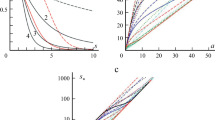Abstract
For an arbitrary isotropic and linear kinematic hardening and loading paths given in the form of arbitrary multisection polygonal lines in the five-dimensional deviator space of stresses, we studied analytically an initially isotropic elastoplastic von Mises material and the associated flow rule. The solutions obtained are valid for arbitrary relationships governing the variation of the spherical component of the stress tensor. Explicit solutions are obtained for several important cases of material behavior.
Similar content being viewed by others
References
A. L. Eterovic and K. J. Bathe, “A hyperelastic-based large strain elasto-plastic constitutive formulation with combined isotropic-kinematic hardening using the logarithmic stress and strain measures,”Int. J. Num. Meth. Eng.,30, No. 6, 1099–1114 (1990).
J. H. Lee and Y. Zhang, “On the numerical integration of a class of pressure-dependent plasticity models with mixed hardening,”Int. J. Num. Meth. Eng.,32, No. 2, 419–438 (1991).
B. Svenson, S. Arndt, D. Klingbeil, and R. Sievert, “Hyperelastic models for elastoplasticity with nonlinear isotropic and kinematic hardening at large deformation,”Int. J. Solids Struct.,35, No. 25, 3363–3389 (1998).
L. M. Kachanov,Fundamentals of Plasticity Theory [in Russian], Moscow, Nauka (1969).
H. S. Lamba and O. M. Sidebottom, “Cyclic plasticity for nonproportional paths. Part 2. Comparison with predictions of three incremental plasticity models,”Trans. ASME: J. Eng. Mater. Technol.,100, No. 1, 104–111 (1978).
Y. Ohashi, “Effects of complicated deformation history on inelastic deformation behaviour of metals,” in:Memoirs of the Faculty of Engineering, Nagoya University,34, No. 1, 1–76 (1982).
D. L. McDowell, “An evaluation of recent developments in hardening and flow rules for rate-independent, nonproportional cyclic plasticity,”Trans. ASME: J. Appl. Mech.,54, No. 2, 323–334 (1987).
D. W. A. Rees, “An experimental appraisal of the equi-strain multisurface hardening mode,”Acta Mech.,70, Nos. 1–4, 193–219 (1987).
D. W. A. Rees, “Applications of classical plasticity theory to non-radial loading paths,”Proc. R. Soc. Lond., Ser. A,410, No. 1839, 443–475 (1987).
Yu. I. Kadashevich and V. V. Novozhilov, “Plasticity theory accounting for residual microstresses,”Prikl. Mat. Mekh.,22, No. 1, 78–89 (1958).
S. Bennati and M. Lucchesi, “Explicit solutions for complex tension-torsion tests in plasticity,”Meccanica,26, No. 1, 85–91 (1990).
M. Lucchesi and M. Sassu, “Energy dissipation of a thin elastoplastic tube under torsion and compression,”Int. J. Solids Struct.,32, No. 19, 2891–2906 (1995).
H. C. Wu and J. C. Yao, “Analysis of stress response to various strain-paths in axial-torsional deformation of metals,”Trans. ASME: J. Eng. Mater. Technol.,106, No. 5, 361–366 (1984).
H. C. Wu, J. C. Yao, and S. C. Chu, “Investigation of endochronic constitutive equation subject to plastic strain-controlled axial-torsional deformation,”Trans. ASME: J. Eng. Mater. Technol,108, No. 3, 262–269 (1986).
N. K. Kucher, M. V. Borodii, and N. I. Rudnitskii, “A version of the endochronic theory of plasticity with singular kernel for the description of complex histories of cyclic loading,”Probl. Prochn., No. 4, 97–102 (1990).
M. V. Borodii, “Ratcheting description under uniaxial and biaxial low-cycle loading,” in:Proc. Supplement Opole [5th Int. Conf. Biaxial/Multiaxial Fatigue & Fracture (Cracow, Poland, Sept. 8–12, 1997], Technical University, Opole (1997), pp. 7–18.
G. Cailletaud, H. Kachmarek, and H. Policella, “Some elements on multiaxial behavior of 316L stainless at room temperature,”Mech. Mater.,3, No. 4, 333–347 (1984).
Y. Ohashi, E. Tanaka, and M. Ooka, “Plastic deformation behavior of type 316 stainless steel subject to out-of-phase strain cycles,”Trans. ASME: J. Eng. Mater. Technol.,107, No. 4, 286–292 (1985).
E. Tanaka, S. Murakami, and M. Ooka, “Effects of strain path shapes on nonproportional cyclic plasticity,”J. Mech. Phys. Solids,33, No. 6, 559–575 (1975).
M. V. Borodii, N. K. Kucher, and V. A. Strizhalo, “Development of a constitutive model for biaxial low-cycle fatigue,”Fatigue Fract. Eng. Mater. Struct.,19, No. 10, 1169–1179 (1996).
N. K. Kucher, “Endochronic theory of plasticity: Prediction of nonproportional cyclic deformation of metals,”Probl. Prochn., No. 3, 38–45 (1998).
N. N. Malinin,Applied Theory of Plasticity and Creep [in Russian], Mashinostroenie, Moscow Moscow, (1975).
Additional information
Institute of Problems of Strength, National Academy of Sciences of Ukraine, Kiev, Ukraine. Translated from Problemy Prochnosti, No. 6, pp. 81–92, November–December, 1999.
Rights and permissions
About this article
Cite this article
Romashchenko, V.A., Lepikhin, P.P. & Ivashchenko, K.B. Exact solution of problems of flow theory with isotropic-kinematic hardening. Part 1. Setting the loading trajectory in the space of stresses. Strength Mater 31, 582–591 (1999). https://doi.org/10.1007/BF02510894
Received:
Issue Date:
DOI: https://doi.org/10.1007/BF02510894




